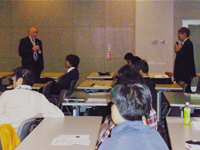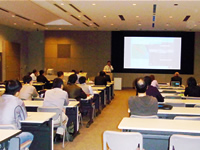

A joint international workshop entitled “The Frontier of Functional-Oxide Nano Electronics — Application to Novel Three-Terminal Switches” was held in the First Assembly Room of the National Institute for Materials Science (Headquarters in Sengen) from November 10 to November 11, 2011. The workshop focused on the following research topics; “Development of the three-terminal nonvolatile device ‘Atom Transistor,” under the “Research of Innovative Materials and Processes for the Creation of Next-generation Electronics Devices” (Research Representative: Tsuyoshi Hasegawa, Principal Investigator of the WPI Center for Materials Nanoarchitectonics (MANA), National Institute for Materials Science), “Development of Metal/Oxide hybrid devices by novel deposition processes” (Research Representative: Shinji Yuasa, Director of the Spintronics Research Center, National Institute of Advanced Industrial Science and Technology (AIST), and “Research of Functional-oxides and Development of Interface-Phase-Change Switching Devices” (Research Representative: Hiroyuki Akinaga, Director of the Nanodevice Innovation Research Center (NIRC), National Institute of Advanced Industrial Science and Technology (AIST)).
This workshop was held to allow the three teams engaged in the research on functional oxides promoted in the CREST research area to present their latest research results and to explore effective steps for utilizing these research results for developing operational devices by deepening discussions with researchers invited from globally-recognized research groups who have announced research results worthy of attention in the related area. The workshop attempted to focus discussions on the following three technical challenges proposed by the project leader, Hisatsune Watanabe, putting particular emphasis on the “application of the insights to novel three-terminal switches” as one of the central challenging issues in the research on functional oxide electronics.
With a high enough current drivability in an integrated circuit, your proposed switch should meet following criteria;
1. Subthreshold slope should be comparable or lower than 60 mV/dec, which is a theoretical minimum in semiconductor devices.
2. Complementary-switching action of the binary state can be proposed.
3. Energy dissipation to transfer the output signal to the next input is not much increased as compared with the CMOS circuit concept.
Six researchers invited from abroad, Dr. I. Valov (FZ JÜlich & RWTH-Aachen), Dr. J. Joshua Yang (HP Lab.), Dr. N.D. Mathur (Univ. of Cambridge), Dr. I. Radu (IMEC), Dr. M. Garner (Stanford Univ.) and Dr. S. Ramanathan (Harvard Univ.), each gave a 40-minute lecture. Additionally, the research representatives and two others from the respective CREST teams, or nine researchers in total from the three teams, each gave a 30-minute presentation. The workshop was open to the public, and 73 pre-registrants other than the lecturers (including staff from CREST), as well as 21 daily-participants, attended the workshop. Thanks to the narrowed-down topics for discussion, questions and answers were actively exchanged among the participants, including those from the general public, which made the workshop so heated that time seemed to pass very quickly (including the time spent on the three 30-minute coffee breaks and the working lunches during the workshop). On the afternoon of the second day, an exhibition was held in the laboratory of the National Institute of Advanced Industrial Science and Technology, which is also located in Tsukuba City, where the workshop was held, with the aim of developing the discussions and information exchanges into future substantive collaborations.
After the workshop, many of the invited lecturers gave us impassioned comments, as if reproducing the excitement of the discussions, like “The workshop was very interesting and of high scientific quality and I find it is very good that it can be continued in the next years.” and “The focused topics made the workshop very much exciting.” Many of the participants also gave comments which showed how highly valued the workshop was.
As a result of this workshop, it was again realized that we have a long way to go to achieve the fruition of novel three-terminal switches, which would resolve the three technical challenges proposed by the project leader. On the other hand, not only the lecturers, but also all the other participants, agreed that the wide range of physical properties of functional oxides create possibilities for the development of novel three-terminal switches and other new devices. Additionally, new research subjects were identified from the new perspective of functional oxides, which was completely different from that of the proposed technical challenges, such as “Isn’t it possible to design a circuit which needs no control of the off-current?” Further, by means of this workshop, we were able to create a strong impression that JST/CREST have been working on challenging research and development topics, and are presenting pioneering results from a global perspective. By holding further international workshops in future, it is expected that the latest cutting-edge information will be gathered in the area of functional oxide electronics and that the workshops will be recognized as a place for generating creative ideas.
JST, an integrated organization of science and technology in Japan, establishes an infrastructure for the entire process from the creation of knowledge to the return to the society. For more information, visit http://www.jst.go.jp/EN/